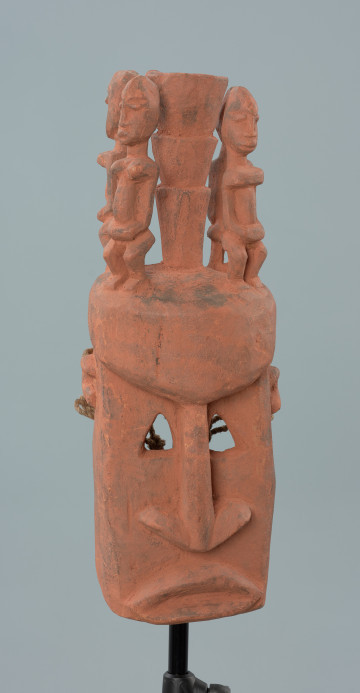
Sirige mask
między 1951 — 1998
National Museum in Szczecin
Part of the collection: Collection of Dogonian art
The mask sirige (in the Sigi-so language awa danu) dances during the Dama funeral festival. The ceremony takes place several years after the funeral proper and is intended to take the nyama life force of the deceased outside the village. Sirige symbolises the storied house of a large family, which is characterised by a facade with small niches situated in several rows. Each niche is dedicated to one actual ancestor of the family. Some houses of the oldest families have even more than 30 such niches. Their owners' souvenirs such as amulets, fetishes, pieces of clothing, etc., are placed in them. At the time of Dama, the dancing sirige represents the house of the great family of the deceased and indirectly all generations, including the future ones. Some believe that sirige resembles a ladder whose rungs are the successive stages of knowledge gained during initiation. Because of its size, many Dogon also claim that it is a bridge between heaven and earth.It is a heavy mask, and dancing in it requires strength, experience and dexterity. It only forms a whole with the costume made of dyed fibres. The sirige mask dances around the square; at one point, it stops and jumps several times high into the air with both legs joined together. Then he leans his head forward, touches the ground with the upper part of the wooden construction and then leans back strongly and again touches the ground with its upper edge. Finally, the dancer bends forward so that the wooden part of the mask is horizontal and turns in a circle.The sirige dance recreates the creation of the world. The mask's movement and bends remind of the Sun's journey across the sky and its life-giving properties.
Ewa Prądzyńska
Author / creator
Dimensions
cały obiekt: height: 375 cm, width: 20,6 cm
Object type
sculpture, mask
Creation time / dating
Creation / finding place
Identification number
Location / status

między 1951 — 1998
National Museum in Szczecin

między 1951 — 2000
National Museum in Szczecin

między 1965 — 1970
National Museum in Szczecin
DISCOVER this TOPIC
Museum of King Jan III's Palace at Wilanów
DISCOVER this PATH
Educational path